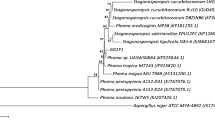Abstract
There is an urgent need to discover new anti-microbial agents that can overcome the increasing antibiotic resistance posed by multidrug resistant, β-lactamase producing bacteria. β-Lactam antibiotics are structurally related through the presence of a core β-lactam ring. Resistant pathogens are able to produce β-lactamase enzymes that hydrolyze the β-lactam ring and inactivate the antibiotic. One approach to counteract this resistance is to develop β-lactamase inhibitors, which, on administration with β-lactams, restores the antibiotic activity for its continued clinical use. In the present study, a fungal Penicillium strain was isolated, identified and characterized for its antimicrobial and β-lactamase inhibition activities. The strain was identified as Penicillium piceum and was grown in suitable media under submerged cultivation. The antibacterial activity was observed against Bacillus subtilis, Staphylococcus aureus, Escherichia coli and Pseudomonas aeruginosa. Higher antimicrobial activity was observed against gram-positive bacteria as compared to gram-negative bacteria. A certain amount of antifungal activity was also observed against the fungal strains of Penicilium chrysogenum, Rhizopus stolonifer, Fusarium moniliforme, Aspergillus niger, Giberella fujikuroi and Saccharomyces cerevisiae. Iodometric and bioassay analyses confirmed that P. piceum produced β-lactamase inhibitors having activity against penicillinase (Bacillus cereus). Solvent-solvent extraction with butanol yielded a three-fold increase in β-lactamase inhibition activity. High-performance liquid chromatography analysis of the concentrated product proved it to be a single compound. The infrared (IR) spectrum of the compound was compared with the reference IR spectra of sulbactam sodium, tazobactam and potassium clavulanate. It was found to be different thereby inferring the need for extensive structural elucidation for future applications.
Similar content being viewed by others
Abbreviations
- CD:
-
Czapek Dox
- HPLC:
-
high-performance liquid chromatography
- IR:
-
infrared
- OD:
-
optical density
- SD:
-
Sabouraud dextrose
- YPD:
-
yeast extract-peptone-dextrose
References
Bohm J., Hoff B., O’ Gorman C.M., Wolfers S., Klix V., Binger D., Zadra I., Kurnsteiner H., Poggeler S., Dyer P.S. & Kuck U. 2013. Sexual reproduction and mating-type-mediated strain development in the penicillin-producing fungus Penicillium chrysogenum. Proc. Natl. Acad. Sci. USA 110: 1476–1481.
Bush K., Jacoby G.A. & Medeiros A.A. 1995. A functional classification scheme for β-lactamases and its correlation with molecular structure. Antimicrob. Agents Chemother. 39: 1211–1233.
Doran J.L., Leskiw B.K., Aippersbach S. & Jensen S.E. 1990. Isolation and characterization of a β-lactamase-inhibitory protein from Streptomyces clavuligerus and cloning and analysis of the corresponding gene. J. Bacteriol. 172: 4909–4918.
Drawz S.M. & Bonomo R.A. 2010. Three decades of β-lactamase inhibitors. Clin. Microbiol. Rev. 23: 160–201.
Holten K.B. & Onusko E.M. 2000. Appropriate prescribing of oral β-lactam antibiotics. Am. Fam. Physician 62: 611–620.
Joshi M., Patel H., Gupte S. & Gupte A. 2013. Nutrient improvement for simultaneous production of exopolysaccharide and mycelial biomass by submerged cultivation of Schizophyllum commune AGMJ-1 using statistical optimization. 3 Biotech 3: 307–318.
Jouenne T. & Junter G. 1990. Do β-lactam antibiotics permeabi-lize the outer membrane of gram-negative bacteria? An electrochemical investigation. FEMS Microbiol. Lett. 68: 313–317.
Kalp M., Totir M.A., Buynak J.D. & Carey P.R. 2009. Different intermediate populations formed by tazobactam, sulbactam, and clavulanate reacting with SHV-1 β-lactamases: Raman crystallographic evidence. J. Am. Chem. Soc. 131: 2338–2347.
McManus M.C. 1997. Mechanisms of bacterial resistance to antimicrobial agents. Am. J. Health Syst. Pharm. 54: 1420–1433.
Mohanty S., Singhal R., Sood S., Dhawan B., Das B.K. & Kapil A. 2005. Comparative in vitro activity of β-lactam/β-lactamase inhibitor combinations against gram negative bacteria. Indian J. Med. Res. 122: 425–428.
Okereke C. & Dudley M.N. 1998. β-Lactam/β-lactamase inhibitor combinations: pharmacodynamic considerations and possible role in the management of bacterial infections in the neutropenic host. J. Antimicrob. Chemother. 41: 43–49.
Perez-Llarena F.J. & Bou G. 2009. β-Lactamase inhibitors: the story so far. Curr. Med. Chem. 16: 3740–3765.
Raper K.B., Thom C. & Fennel D.I. 1949. A Manual of the Peni-cillia. Williams & Wilkins Co., Baltimore.
Sawai T., Takahashi I. & Yamagishi S. 1978. Iodometric assay method for β-lactamase with various β-lactam antibiotics as substrates. Antimicrob. Agents Chemother. 13: 910–913.
Shaikh S., Kaul P. & Tandon G.D. 2014. β-Lactamase inhibitors from indigenous herbs and spices. Res. J. Pharm. Biol. Chem. Sci. 5: 275–285.
Sharma P., Kaul P., Khetmalas M.B. & Tandon G.D. 2013. Antibacterial, antialgal and β-lactamase inhibition activity of Penicillium purpurogenum var rubrisclerotium. Indian J. Res. 2: 17–19.
Solanki S.S. & Selvanayagam M. 2013. β-Lactamase inhibitory potential and antibacterial potentiation of certain medicinal plants and extracts against extended spectrum β-lactamase producers. Adv. BioTech. 12: 6–10.
Tenover F.C. 2006. Mechanisms of antimicrobial resistance in bacteria. Am. J. Med. 6: 62–70.
Vinod N.V., Haridas M. & Sadasivan C. 2010. Isolation of 1,4-naphthalenedione, an antibacterial principle from the leaves of Holoptelea integrifolia and its activity against β-lactam resistant Staphyloccus aureus. Indian J. Biochem. Biophys. 47: 53–55.
Weiss W.J., Peterson P.J., Murphy P.M., Tardio L., Yang Y., Bradford P.A., Venkatesan A.M., Abe T., Isoda T., Mihira A., Ushirogochi H., Takasake T., Projan S., O’ Connell J. & Mansour T.S. 2004. In vitro and in vivo activities of novel 6-methylidene penems as β-lactamase inhibitors. Antimicrob. Agents Chemother. 48: 4589–4596.
Acknowledgements
The authors would to like to express their gratitude and thanks to Dr. D.Y. Patil Vidyapeeth (DPU) and Dr. D.Y. Patil Biotechnology and Bioinformatics Institute, Tathawade, Pune for providing the required research facilities. The authors are also thankful to Dr. R.K. Nanda, Padmashree from Dr. D.Y. Patil Institute of Pharmaceutical Sciences and Research, Pune, for providing the FTIR facility.
Author information
Authors and Affiliations
Corresponding author
Additional information
Based on a contribution presented at the International Conference on Advances in Biotechnology & Bioinformatics (ICABB-2013), November 25–27, 2013, Pune, Maharashtra, India
Rights and permissions
About this article
Cite this article
Dubey, S., Patil, K., Sharma, P. et al. Penicillium piceum: a potential source for antimicrobial agents and β-lactamase inhibitors. Biologia 70, 19–26 (2015). https://doi.org/10.1515/biolog-2015-0013
Received:
Accepted:
Published:
Issue Date:
DOI: https://doi.org/10.1515/biolog-2015-0013




